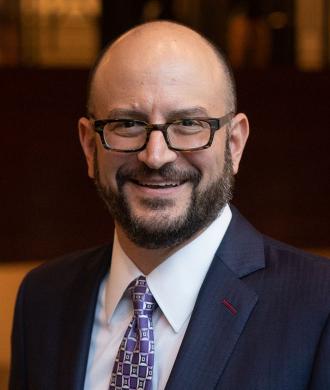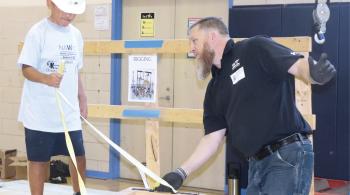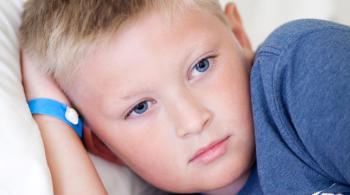We are in the midst of an unprecedented mental health crisis in this country that has especially impacted children. According to experts, an estimated one in five youth has an undiagnosed mental, emotional or behavioral disorder—yet many do not get the help they need. May is known as Children’s Mental Health Awareness Month and in this month’s episode of Your Child’s Brain, Dr. Brad Schlaggar is joined by Dr. Ernestine Briggs-King to discuss the impact that traumatic stress can have on a child’s social and cognitive development, academic performance and overall well-being.
Resources:
- Kennedy Krieger Center for Child and Family Traumatic Stress
- Substance Abuse and Mental Health Services Administration
- Kennedy Krieger Chill Out Mind Mental Health Resources
Learn More About Kennedy Krieger Faculty & Staff Members Featured in This Episode
Learn More About Kennedy Krieger Faculty & Staff Members Featured in This Episode
View Episode Transcription
Dr. Brad Schlaggar (BS): Welcome to Your Child's Brain, a podcast series produced by Kennedy Krieger Institute with assistance from WYPR. I'm Dr. Brad Schlaggar, Pediatric Neurologist, and president and CEO of Kennedy Krieger Institute. May is known as Children's Mental Health Awareness Month, providing us an opportunity to acknowledge the importance of children's mental health to show that positive mental health is essential to a child's healthy development from birth and promote positive youth development, resiliency, and recovery. We are in the midst of an unprecedented mental health crisis in this country that has especially impacted children. As highlighted by the former Surgeon General Dr. Vivek Murthy, there has been a continued rise in the number of children diagnosed with anxiety, depression, and other mental health conditions. An estimated one in five youth has a diagnosable mental, emotional, or behavioral disorder, yet many do not receive the help they need. Mental health issues can have a significant impact on children's social and cognitive development, academic performance, and overall well being. Early recognition, intervention, and support are crucial for preventing long term consequences. By raising awareness and providing resources, this Children's Mental Health Awareness Month aims to empower families and communities to prioritize and support the mental health of children. One major driver for mental health challenges, and the topic for this month's episode of Your Child's Brain is trauma and traumatic stress. Of course, when one hears the word trauma, it's natural to think of the physical consequences of traumas. Importantly, and as we'll discuss today, trauma and traumatic stress, in particular, can have profound effects on our mental health, especially for the developing child. To share this conversation about children's mental health, I'm joined by my exceptional colleague, Dr. Ernestine Briggs-King, Dr. Briggs-King, a community psychologist, is Vice President of the Department of Family and Community Interventions at Kennedy Krieger, where she also directs the Center for Child and Family Traumatic Stress. Doctor Briggs-King moved to Kennedy Krieger in June of 2024 from Duke University, where she was an associate professor in psychiatry and Behavioral Sciences. She's now an Associate Professor (PAR) of Psychiatry and Behavioral Sciences at Johns Hopkins University School of Medicine. Welcome Ernestine. Now, before we get started, We want to say that if anyone listening is struggling or in crisis, help is available through the 988 suicide and crisis lifeline. You can call, chat, or text, to speak with caring counselors. The service is available for those facing mental health struggles, emotional distress, alcohol, or drug use concerns or who just need someone to talk to. Ernestine Let's start with some basics. Could you define trauma, traumatic experiences, and traumatic stress, especially from a mental health perspective?
Dr. Ernestine Briggs-King (EB-K): Thanks, Brad. Thanks for inviting me and thanks for sharing that 988 resource. I think that's really important. Trauma is an event, a series of events, or things that overwhelm an individual's ability to cope. It can be caused by various experiences such as a serious accident, like a car accident or the bridge collapse or natural disasters like hurricanes, earthquakes, wildfires. Abuse and violence or the loss of a loved one. A person can experience these events directly, or it could be them witnessing an event happening to a family member, a friend, or a loved one. All of those things tend to overwhelm a person's emotional, cognitive, and physical well being. I think about trauma as a normal reaction to an abnormal or overwhelming event. Traumatic stress is more like the reactions. How people respond, and they might include things like flashbacks or nightmares, anxiety, difficulty concentrating. But it's again, the body's way of responding to intense stress caused by the traumatic event.
BS: In recent years, we've been hearing about this constructive ACEs or adverse childhood experiences, ACEs as the acronym. They're recognized to have potentially lifelong consequences for those who are experiencing them, the connection between ACEs and a multitude of chronic health conditions has now been studied for really nearly three decades now. Could you help us understand what are ACEs, and how do we measure or study them?
EB-K: Yeah. ACEs are potentially traumatic events that occur during childhood. The original work on ACEs was done by Dr. Vincent Felitti and his colleagues at the CDC, Bob Anda, and others. They originally started off with 10 ACEs that include things like physical, sexual, emotional abuse or neglect, domestic violence or intimate partner violence, where the mother was treated violently. Then household dysfunction or growing up in a household where a family member or caregiver was using substances or had mental health problems, but also included in that original ACEs were things like parental separation and divorce or separation from a parent due to incarceration. That literature has blossomed over the last 30 years, as you mentioned, and there's so much more that we know about trauma and about exposure to trauma that we're learning, and those 10 ACEs have been expanded exponentially to include things that happened in the community, like poverty, homelessness, food insecurity, racism, violence, and the environment. Not just hurricanes and wildfires and floodings, but some of the newer models include things that happened during the pandemic that include chronic illness and disease? We are learning way more about the things that impact children and their impact over the course of the lifetime. Some of the studies are showing heart disease and things like anxiety and depression, would also shortened lifespans.
BS: Do we have any statistics on how common adverse childhood experiences or ACEs are?
EB-K: We have learned a little bit about ACEs over the years. We know that some of our shifts in language have impacted our numbers. We know that some of the studies are showing about 64% of adults in the United States report experiencing at least one type of ACE before age 18. We have other studies that suggest that nearly one in six adults, about 17.3%, report experiencing four or more types of ACEs. Depending on who we're surveying, for example, high school students, some of the more recent data suggests that three and four high school students reported experienced one or more ACEs, and one in five experienced four or more. That number of four or more is really important because that's the tipping point for ACEs that shows increased negative outcomes associated with more exposure.
BS: A moment ago, we were talking about the different types of ACEs and that initially, the roster had 10 and it's grown in number. You're just mentioning that the tipping point is having at least four or more really sets one up for more negative outcomes. I'm wondering if the kinds of experiences or the categories of potentially traumatic experiences, whether they lead to different types of outcomes.
EB-K: There's a lot of literature looking at outcomes associated with different types of ACEs, for example, physical abuse and looking to see if that leads to things like aggressive behavior or substance abuse in adulthood or neglect, impacting relationships or people's experiences of self esteem or self worth. But some of the more interesting research that I've been doing really suggests that it's not a one to one situation. That there's some synergy that happens with certain pairs of ACEs. For example, when you mix sexual abuse with physical abuse, some of my research is showing that that has exponentially more of an outcome, expected outcome than just simply having one or the other. These combinations or these synergies or these peers are something that researchers are really beginning to tackle and try to understand, especially because most things don't happen alone. They happen in context. Really understanding that is an important part of us understanding more about how ACEs impact our well being.
BS: What are the primary risk factors for experiencing trauma or potentially traumatic experiences, especially for children?
EB-K: There are a number of risk factors. I think we could categorize them in terms of individual, family, and community level. For example, individual risk factor might be having a child with special needs or with chronic illness or complex medical conditions or mental health issues. Another individual risk factor might be like social isolation, having a few friends or family members or limited support. On the family level, I think thinking about caregivers with challenges, either in terms of having limited parenting skills or maybe not understanding development or their needs of their children. Having a parent with the history of trauma might increase the risk of having a child with trauma. Then things that you might think about, like poverty, low SES, limited resources, high stress, all of those are risk factors, as well as again, connection or isolation and not having extended family, friends, or neighbors. Then there are certain styles of communication, whether they be negative communication styles or styles which include high conflict that may increase the likelihood of trauma happening. Then finally, from the community perspective, neighborhoods where there's limited community involvement or engagement, maybe high crime rates, or limited resources, economic opportunities, or high unemployment rates, or high levels of substance use may contribute to additional risk factors for children and families.
BS: Taking a step back and from your perspective as a psychologist, how would you answer why trauma or traumatic experiences are so impactful on a developing child?
EB-K: I think, put simply, trauma disrupts normal development as we think about it. It disrupts our brains and brain development. It disrupts our sense of safety. It disrupts emotional and behavioral regulation and our ability to manage those responses. It disrupts our relationships and our attachment. Then as you can think about these things, over time, it influences our mental health, our physical health, our well being.
BS: You you alluded to it earlier. But in addition to trauma affecting the structure and function of the developing brain. It also has implications for other systems in the body, cardiovascular, metabolic, and so forth. What have we learned about the impacts of trauma and aces on those other body systems and the consequences for long term health.
EB-K: As a pediatric neurologist, you're probably really aware of the brain structures that get involved. You think about amygdala, and you think about our emotions and how threats can really lead to other responses or a hippocampus, which is so involved in memory and memory consolidation and really helping us think through how we're going to respond in these things. Then the prefrontal cortex is really important in terms of decision making, impulse control, solving problems. All of those things are really important. Then it has additional impact on our parasympathetic are sympathetic nervous systems. We see the fight or flight response and in the case of the parasympathetic nervous system, we see the freeze response or immobilization and sometimes dissociation. All of that and the imbalance of all the things that happen when all those things are activated, the cortisol, the adrenaline, all those hormones that come to really protect the body and let us survive threat. When those things get out of imbalance, we start to see other problems happening. We see it happening in terms of our heart health, in terms of inflammation, in terms of our endocrine response and all of those together create situations that are right for further disease and problems to happen physically for us.
BS: You talked about the framing of ACEs around zero birth to 17 years of age. But developmentally, a two year-old is different than a 15-year-old, for example, how does the age or developmental stage of a child influence the way that trauma or traumatic stress impacts them?
EB-K: I think trauma impacts us differently. It looks different throughout the different developmental stages. For young children, we may see more crying, more screaming, excessively, more difficulty with irritability, but it may also show up as clinging and having difficulty separating for slightly older children, maybe school age children. It might look like regression of previously learned skills. Maybe in the area of toileting, you might see temper tantrums and more irritability. Then older kids, you might see going from 0-100 in terms of their emotions or their impulses, not being able to be regulated as effectively. We know that it impacts our memories and all things. Our ability to regulate our affect and our emotional responses. But also our connections to other people, our attachments in our relationships. Young children may have difficulty separating or seem overly clingy, and older kids may seem like totally unattached. Like, they don't care if they're alone or just completely isolated. It just shows up differently, and I think really understanding those developmental nuances as part of our jobs as mental health professionals to understand how trauma is showing up, because it's not the same for every individual.
BS: Speaking of individual differences, not all children will experience traumatic stress after exposure to trauma in the same way. What resilience factors may help reduce the adverse impact of experiencing trauma?
EB-K: We know probably the most important protective factor that fosters resilience is connection. Connection to people. It doesn't have to be a whole cadre of people. It could be just one important person that an individual feels connected to could really change the course of the trajectory of how trauma impacts them. We see this time and time again from early infants to older adults, that connection piece is really important and we see that in our mental health treatments as well. We try to build that connection, those relationships, that sense of attachment to someone else because that's really important in mediating some of the effects of trauma. Other protective factors, some of them we're born with. Those things that make us and really help us think about the way we see ourselves, our drive, our motivation. Some of those things are really our temperament are really important as well and those are things that we try to address in our treatments.
BS: As a clinician, when you're tasked with assessing a child with what you think is a traumatic stress related disorder, how do you go about that initial assessment? What are the key factors that are part of that intake to understand as effectively as possible, the situation that child is in?
EB-K: What we do is we invite the family in and we learn about their experiences. For parents, we learn about their previous exposures or things that might impact their parenting or their ability to be supportive and the resources that they need for children? We learn more about what's happened to them and how the individuals around them respond and what their needs are and how maybe trauma may be showing up. Most times it's the behavior that brings them in the door. Johnny may not be doing all the things that he used to do or he may not be as respectful as he used to be or he's not paying attention or doing something differently that catches the eye of someone else. But sometimes it could be that Johnny or Sarah's had and withdrawn, and that might be a change in their behavior as well. Really having a sense of what's going on and really talking to the people in their environment to get a sense of how best to intervene.
BS: Sometimes that parent, or those parents who are so important for the implementation of a treatment plan may also be experiencing the same traumas, and traumatic experiences as their child. How do you incorporate that aspect of trauma into a care plan when you have potentially a family experience?
EB-K: I think context matters a lot, and I think what you're talking about is the context for that family. For many of the families that I serve, it's been intergenerational trauma. Their parents experienced these things, and their grandparents experienced these things, and their kids are experiencing these things. Those are where those social drivers of health really come into play, and really understanding about poverty, and context, and other things really become important to understanding the needs of the family. But also thinking about even in those situations, even if we can identify a school teacher, a religious leader, a neighbor that the family can derive some support for, we have a really good chance of helping the family get to a space where they can feel secure, stable and can nurture their child back.
BS: Can you give us, maybe in broad strokes, an overview of the kinds of treatment approaches that you bring to children and families who have experienced trauma?
EB-K: Yeah. The good news is trauma is treatable, and we have, over the last 40 years, developed a range of evidence-based. That means that there's research behind it, and we know it's effective treatments for children and families. I won't go into the alphabet soup of what they are, but I will give you a sense of what they do. Some teach coping skills. How to cope with your environment, how to navigate it. Some teach things like mindfulness skills, or deep breathing skills to help you calm in times when you're activated or having a difficult time. Some of the treatments we use have narrative components where you can really talk about what happened to you, and really, I think, an exposure component, which means that you're taking the sting out of the story or the narrative of the event, and helping the person just file them away very differently so that they're able to cope better with the experiences that they have. Doesn't erase that the trauma has happened, but it changes the way they think about the trauma that has happened to them. Then all of our treatments really work towards increasing safety, and you guessed it, support, because those things are important to really helping families continue, and those things are in the natural environment. Once those get disrupted, we want to really work towards replacing and fixing those things as well.
BS: There's this term that is used often, nowadays, trauma-informed care. Can you unpack what is meant by that phrase, trauma-informed care?
EB-K: Yeah, that's the new buzzword, trauma-informed care. Everybody's doing it. But I think at its essence, what was really meant by trauma-informed care is that we think about the experiences of the family. We think about issues of safety, issues of trust. We think about the context, and so knowing about their cultural experiences, knowing about their community experiences, all of those things are important to doing that. I guess, like most doctors, we try not to do any harm. In the case of trauma, we try not to re-traumatize our clients and families, but we want to really provide them what they need to be successful in navigating their experiences.
BS: I think for a last question, Ernestine, I always love asking this question. What area of research in this field do you find most compelling? You can include your own, but what do you think is the next really important direction that the field is going, and the research that would support that?
EB-K: I would love to say just my own, but there's so much innovative research happening, I think about what we're doing in terms of trauma-informed care, and really creating trauma-informed communities. That's really exciting to me because we're bringing the work out of our labs, and hospitals, and medical centers, and bringing it in the context of the community, and making it extremely accessible because we know trauma is so prevalent. That's one thing excites me. I think in my next life, I'm going to be a technology person because I am excited about, even though it's a little scary, the use of AI in our training of our workforce. I'm working with some folks right now that are using things like AI to help us figure out how we train the workforce, how do we help them become more trauma-informed in their responses and their care for families. That's pretty cool. We know about telehealth, but there's some new advances, and even in that field, and thinking about digital tools, and apps and things that we can use to really help our families on a day to day. When they're not in the presence of us great mental health treating providers, that they can have the things that they need to be successful. There's so much going on, but those are the highlights. I could go into the research thing and talk about machine learning, and how we're using large amounts of data and harmonizing that data, to really understand what works and for whom. I think at the end of the day, we want to make sure that our treatments are effective, and that we guide them based on scientific knowledge, knowledge of what we know about us as individuals, and really just make it accessible.
BS: Well, that is an excellent place to end. Thank you to our guest, Dr. Ernestine Briggs-King, as we bring further awareness to reduce the stigma and elevate the importance of children's mental health, reduce and promote early intervention, and support for young people struggling with mental health issues. We hope that you, our listeners have found this discussion about trauma, traumatic stress, and mental health informative and helpful. Please check out our entire library of topics on your child's brain at wypr.org, KennedyKrieger.org/ycb, or wherever you get your podcasts. You've been listening to Your Child's Brain. Your Child's Brain is produced by Kennedy Krieger Institute, with assistance from WYPR and producer Mark Gunnery. Please join us next time as we examine the mysteries of your child's brain.

















